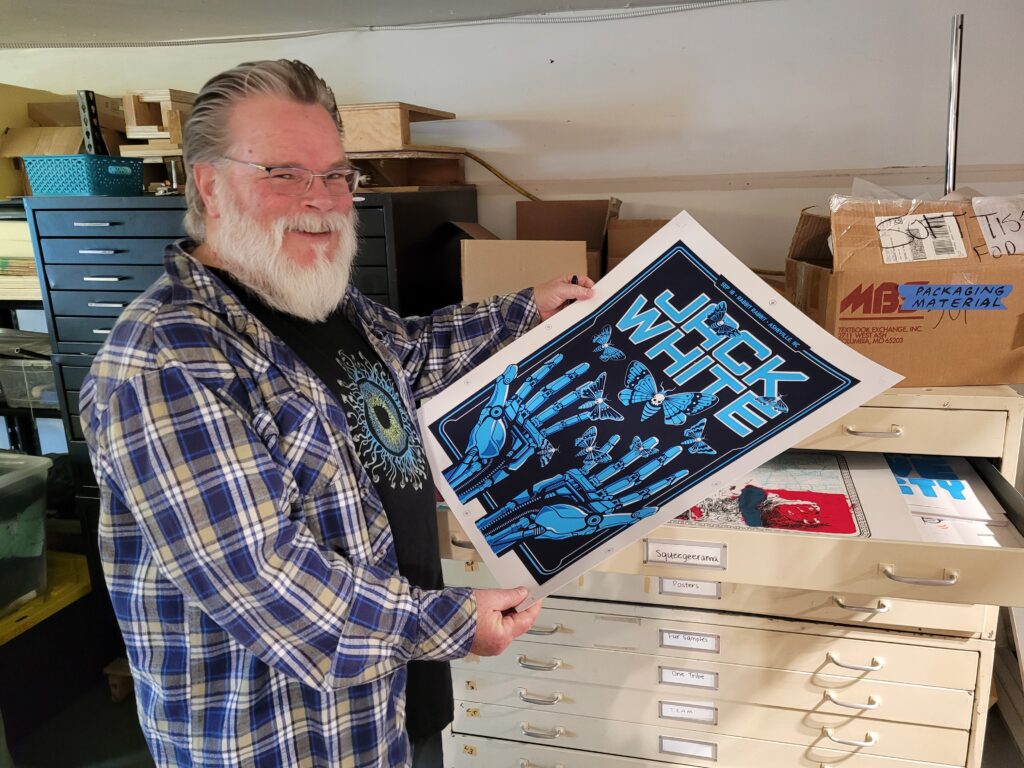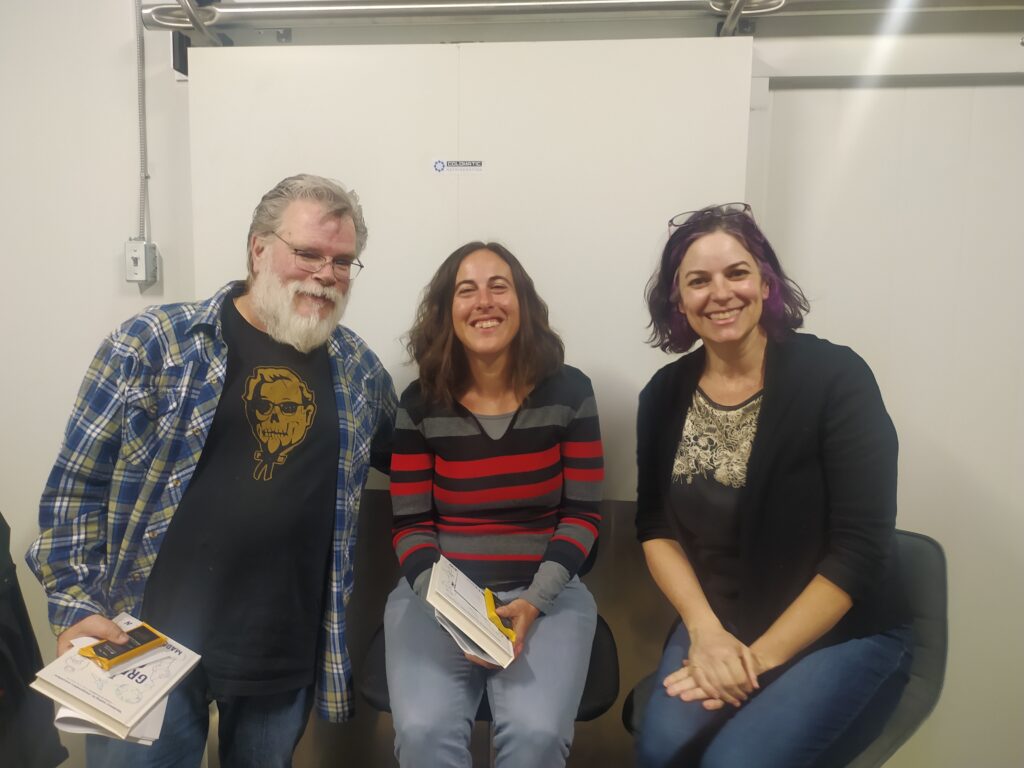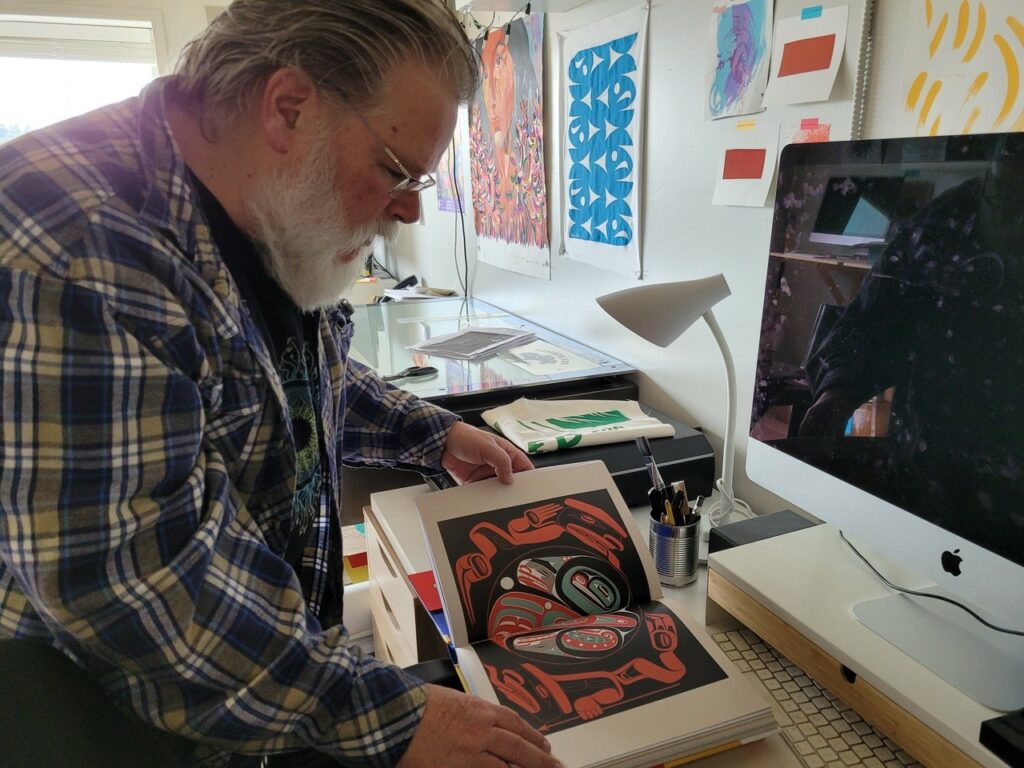I call it a gateway drug, because it can be a springboard to so many other things. And if I can see a business start or grow because of screen-printing, then that makes it all worthwhile. I believe in the human ability to learn and to take on anything.”
– Andy MacDougall, Screen-print Expert, Wachiay Studio
Where most people see ink, Andy MacDougall sees potential. Screen-printing – the technique of transferring ink (or dye or other materials) through a mesh and onto a shirt, paper, wood, glass, metal, plastic, Covid Rapid testers, cell phones, solar cells, batteries… basically anything you want and often hidden from sight – has not had a bad rap over the last many years. It’s had almost no rap at all.
“Screen printing is one of those art and print technologies that sometimes gets dismissed as old and simple,” says Andy speaking from Wachiay Studio, a 1500 square foot section of the Wachiay Friendship Centre, a Courtenay-based nonprofit delivering programs and services to urban Indigenous people in the Comox Valley, and those experiencing homelessness, unemployment or underemployment.

“I became fascinated with screen-printing because you could make stuff, compared to what I was doing at the time – designing ads to sell things,” he says.
Even though Andy officially retired from running the studio in 2021, and his successor Scott Henley now operates the space, Andy’s ongoing passion for keeping the art form alive has meant that he continues to help create opportunities for people – particularly youth and Indigenous community members – to learn a new skill that can also help them earn a living.
Today, he and Scott continue to produce textiles, art prints and more in the space. Andy also continues to teach weekend courses and provides consulting services to clients ranging from individuals making t-shirts to manufacturers making hydrogen fuel cells, circuit boards, snowboards, skateboards, even reproduction glass for old clocks and gas pumps. The list of screen-printing clients can be, quite literally, endless.
“For me, screen printing is about developing your abilities, working hard, being intelligent, and learning,” he says.
The learning part has been something Andy has been a part of, both on the receiving and delivering side, for decades. His foray into screen-printing goes back to the pre-digital era, nearly 50 years ago, after his dad (“a marketing guy”) first taught him how to letter. Andy, who was a musician at the time, started doing band posters, followed by lettering window signs in Edmonton, then a stint as advertising manager for a chain of automotive retail stores. He created newspaper ads, radio, and TV commercials, before being introduced to screen-printing, where he ultimately found his passion. Fast forward several years, through stops as a screen-printing apprentice, worker, then business owner in Courtenay, Vancouver, Yaletown, Langley, then back to the Comox Valley, where in 1993 Andy started working with water-based printing (“a major turning point from solvent-based ink”) and many First Nations artists, creating Limited Edition art.
“Within First Nation culture, art is held in high regard. Pre-settler history, art was used in and on everything, and good artists were held in high esteem. That’s been passed down and a way of continuing culture – a touchstone back to pre-potlatch days. Printmaking became a part of this culture.”
In 2012, Andy and K’ómoks First Nation artist Andy Everson started an afterschool program with Wachiay staff every Wednesday for high school kids to learn Northwest Art and screen-printing.
“It really resonates with the youth. They think it’s so cool! It’s just like magic when you lift that screen up… and they get to use their own designs to make things. It’s really developing an understanding that you can do it – anyone, really – and you can actually create something with the process.”

A couple of years (and many students later) after starting the afterschool program, Andy was approached by the Wachiay Friendship Centre Executive Director and asked to put in a screen-printing studio where an old radio station used to be. Andy didn’t hesitate.
“The initial idea was to set up as a social enterprise, with profits going into sustaining the business and the Wachiay Friendship Centre,” says Andy, who has since participated in several social enterprise programming initiatives carried out by Scale Collaborative, an Island Coastal Economic Trust partner, including SE Catalyst. “This way has allowed us to develop and do good things in the community.”

And by good things, Andy means using the studio and the training as an incubator to help countless more local businesses, individuals, schools, and the private sector to create or enhance products that allow them to branch out and create more local economic activity. The Studio also does fine art printing, posters, and even prints drums and boxes for clients that range from Plains Cree artist George Littlechild to Care Closet Fundraiser in Long Beach, California.
“I am constantly fascinated by who finds screen-printing, and where they go with it,” says Andy. “It’s really up to the person, themselves, to generate something that earns money. And it makes me feel so good to be a part of this process.”
Andy has not only been part of the process, but an instrumental catalyst in keeping it alive. Not only did Andy write a popular instruction manual on screen printing, but his daughter, an Emily Carr alumni and current art director at Figure 1 in Vancouver, designed it as her class project. The father/daughter duo also worked together to help produce ‘A History of Screen-printing’.

In 2003, Andy started writing for Screen-printing Magazine as well as his own column, Shop Talk. The latter then morphed into Art, Ad, or Alchemy, a column and podcast featuring interviews with people from around the world who use the screen-printing process in all of its infinite uses.
Continually pursuant of other avenues to promote screen-printing, Andy started Squeegeerama, in 2016. This annual, week-long printing event held, in the Comox Valley, is going into its sixth year. The event has attracted big names in the screen-printing world, including Dan Stiles, a Portland-based artist and designer known internationally for his innovative electrified rock posters.
With such an extensive list of contributions made to the promotion of screen-printing, it’s no surprise that Andy was inducted into the International Academy of Screen and Digital Printing Technology.
“You can literally do screen-printing from anywhere, with very little investment and technology,” says Andy who encourages folks down in California to ride their screen-printer-equipped-bikes around to music festivals and events.
“We have to get around the idea that mixing art and business is a bad thing, and that products can only be made overseas. The sooner we rediscover local manufacturing, the better off our communities will be. And people can become makers and creators instead of just consumers.”
When asked about his retirement and the legacy he hopes to leave behind, Andy feels a range of emotions.
“I feel really lucky to have the opportunity to share this with so many people because it’s something that few people know how to do anymore,” he says. “But I do get a little sad when people so easily dismiss it as an outdated print and manufacturing technology. I call it a gateway drug (in the very best sense) because it can be a springboard to so many other things. And if I can see a business start or grow because of screen-printing, then that makes it all worthwhile. I believe in the human ability to learn and to take on anything.”
###
Get in touch with Andy
Wachiay Studio
1625 McPhee Ave, Side Door
Courtenay, BC Canada V9N 3A6
www.wachiaystudio.com
www.screentheworld.org
andy.squeeg@shaw.ca
Hours: 10 am – 4.30 pm Monday through Thursday.
Visits are by appointment only.